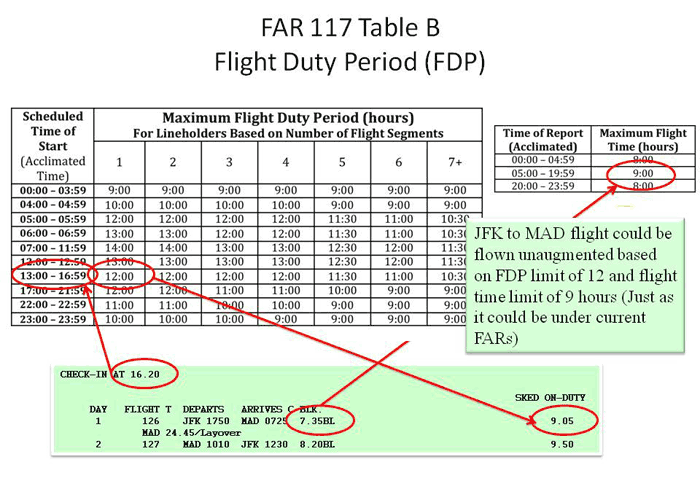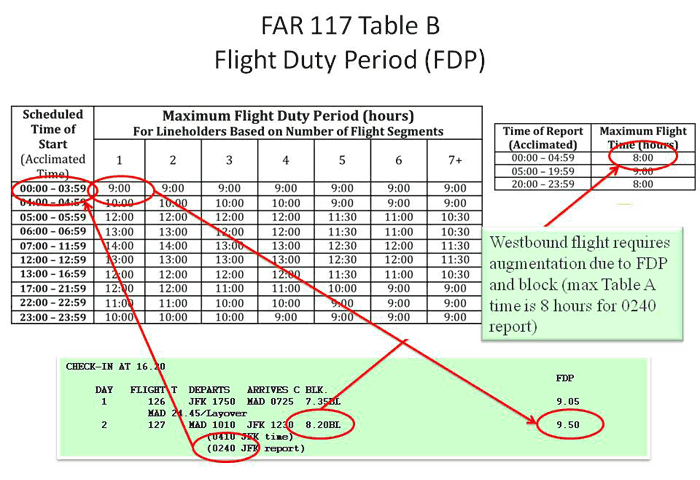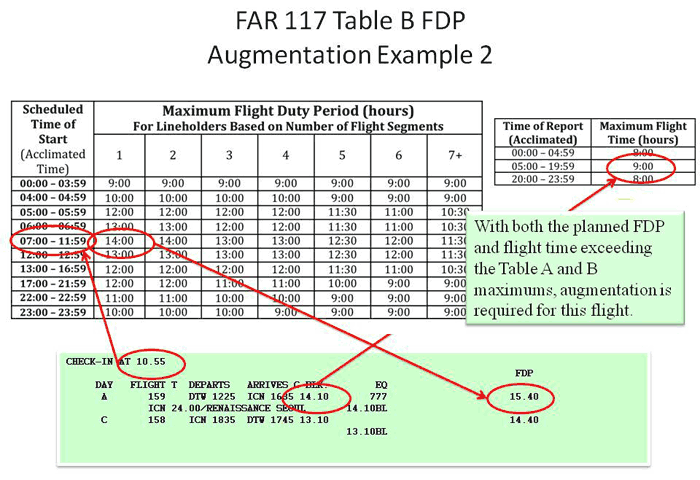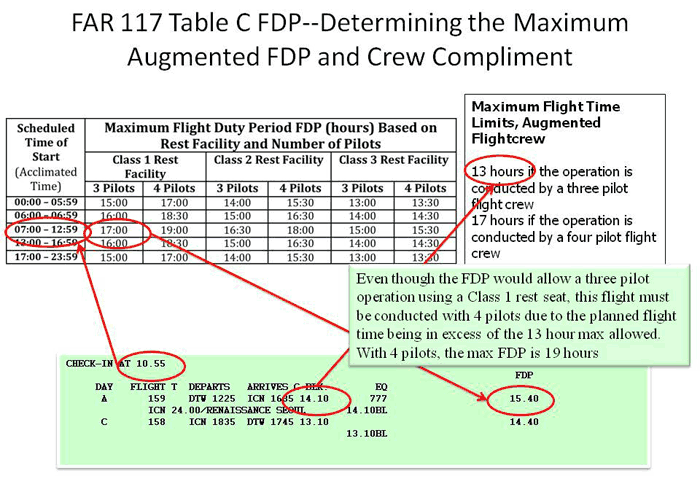|
In the December 23, 2011
FastRead, we
outlined some of the
major differences
between the current FAR
Part 121 and the FAA’s
new FAR Part 117,
particularly for
unaugmented operations.
This Fastread
will highlight the
augmentation provisions
contained in the new
FAR. Note that we are
not describing these
changes in terms of
domestic and
international. The new
FAR Part 117 was
specifically designed to
cover all operations,
without differences in
international, domestic
or supplemental
operations. This is just
another important point
as to why there should
be no distinction
between cargo and
non-cargo operations and ALPA will continue to
push to have cargo
operations included.
Remember, while the FAA
announced and released
their new regulation on
December 21, 2011, the
new FAA regulations do
not take effect for 2
years, allowing time for
your company, working
with your MEC, to
develop an
implementation plan. FAR Part 117 Flight Duty
periods—Augmented Operations (Table C)
|
Scheduled Time
of Start
(Acclimated Time) |
Maximum Flight Duty Period FDP
(hours)
Based on Rest Facility and Number of Pilots
|
|
Class 1 Rest Facility
|
Class 2 Rest Facility
|
Class 3 Rest Facility
|
| 3 Pilots
|
4 Pilots
|
3 Pilots
|
4 Pilots
|
3 Pilots
|
4 Pilots |
| 00:00 –
05:59 |
15:00
|
17:00
|
14:00
|
15:30
|
13:00
|
13:30 |
| 06:00 –
06:59 |
16:00
|
18:30
|
15:00
|
16:30
|
14:00
|
14:30 |
| 07:00 –
12:59 |
17:00
|
19:00
|
16:30
|
18:00
|
15:00
|
15:30 |
| 13:00 –
16:59 |
16:00
|
18:30
|
15:00
|
16:30
|
14:00
|
14:30 |
| 17:00 –
23:59 |
15:00
|
17:00
|
14:00
|
15:30
|
13:00
|
13:30 |
Table C, Maximum
Flight Duty
periods—Augmented
Operations, defines the
maximum flight duty
period that an
acclimated augmented
flight crewmember may be
assigned or accept. It
is very important to
remember that this chart
is the maximum FDP, not
the maximum flight time.
Just like Table B,
Maximum Flight Duty
Period, unaugmented
operations, the chart is
entered using the
report time for
the FDP.
Note: The ARC
recommendations and the
Notice for Proposed
Rulemaking (NPRM) had
the Scheduled Time of
Start based on either
home base time or
acclimated time. ALPA
believes that this
should have been
retained and will work
with the FAA to obtain
further clarification.
It is important since it
will have an effect on
FDP lengths for west
coast pilots starting
duties on the east coast
and vice versa. We will
have more information in
the future.
Before we run through
some examples describing
how to use this chart,
here are some
definitions and tables A
and B that we’ll be
using (these are not all
of the definitions, just
those used in the
following examples):
“Acclimated”
means a condition in
which a flightcrew
member has been in a
theater for 72 hours or
has been given at least
36 consecutive hours
free from duty.
“Augmented
Flightcrew”
means a flightcrew that
has more than the
minimum number of
flightcrew members
required by the airplane
type certificate to
operate the aircraft to
allow a flightcrew
member to be replaced by
another qualified
flightcrew member for
in-flight rest.
“Duty”
means any task that a
flightcrew member
performs as required by
the certificate holder,
including but not
limited to flight duty
period, flight duty,
pre- and post-flight
duties, administrative
work, training, deadhead
transportation, aircraft
positioning on the
ground, aircraft
loading, and aircraft
servicing.
“Flight duty
period (FDP)”
means a period that
begins when a flightcrew
member is required to
report for duty with the
intention of conducting
a flight, a series of
flights, or positioning
or ferrying flights, and
ends when the aircraft
is parked after the last
flight and there is no
intention for further
aircraft movement by the
same flightcrew member.
A flight duty period
includes the duties
performed by the
flightcrew member on
behalf of the
certificate holder that
occur before a flight
segment or between
flight segments without
a required intervening
rest period. Examples of
tasks that are part of
the flight duty period
include deadhead
transportation, training
conducted in an aircraft
or flight simulator, and
airport/standby reserve,
if the above tasks occur
before a flight segment
or between flight
segments without an
intervening required
rest period.
“Rest facility”
means a bunk or seat
accommodation installed
in an aircraft that
provides a flightcrew
member with a sleep
opportunity
(1) “Class 1 rest
facility” means
a bunk or other surface
that allows for a flat
sleeping position and is
located separate from
both the flight deck and
passenger cabin in an
area that is
temperature-controlled,
allows the flightcrew
member to control light,
and provides isolation
from noise and
disturbance.
(2) “Class 2 rest
facility” means
a seat in an aircraft
cabin that allows for a
flat or near flat
sleeping position; is
separated from
passengers by a minimum
of a curtain to provide
darkness and some sound
mitigation; and is
reasonably free from
disturbance by
passengers or flightcrew
members.
(3) “Class 3 rest
facility” means
a seat in an aircraft
cabin or flight deck
that reclines at least
40 degrees and provides
leg and foot support.
Table A, Maximum
Flight Time Limits,
Unaugmented Flightcrew
|
Time of
Report (Acclimated)
|
Maximum
flight time
(hours) |
|
00:00-04:59
|
8:00 |
|
05:00-19:59
|
9:00 |
|
20:00-23:59
|
8:00 |
Maximum Flight
Time Limits, Augmented
Flightcrew
• 13 hours if the
operation is conducted
by a three pilot flight
crew
• 17 hours if the
operation is conducted
by a four pilot flight
crew
Table B, Maximum
Flight Duty Period,
Unaugmented Operations
|
Time of
Start
(Acclimated
Time)
|
Maximum
Flight Duty
Period
(hours)
For Lineholders
Based on
Number of
Flight
Segments
|
|
1
|
2
|
3
|
4
|
5
|
6
|
7+ |
|
00:00-03:59
|
9:00
|
9:00 |
9:00
|
9:00
|
9:00
|
9:00
|
9:00 |
|
04:00-04:59
|
10:00
|
10:00
|
10:00
|
10:00
|
9:00
|
9:00
|
9:00 |
|
05:00-05:59
|
12:00
|
12:00
|
12:00
|
12:00
|
11:30
|
11:00
|
10:30 |
|
06:00-06:59
|
13:00
|
13:00
|
12:00
|
12:00
|
11:30
|
11:00
|
10:30 |
|
07:00-11:59
|
14:00
|
14:00
|
13:00
|
13:00
|
12:30
|
12:00
|
11:30 |
|
12:00-12:59
|
13:00
|
13:00
|
13:00
|
13:00
|
12:30
|
12:00
|
11:30 |
|
13:00-16:59
|
12:00
|
12:00
|
12:00
|
12:00
|
11:30
|
11:00
|
10:30 |
|
17:00-21:59
|
12:00
|
12:00
|
11:00
|
11:00
|
10:00
|
9:00
|
9:00 |
|
22:00-22:59
|
11:00
|
11:00
|
10:00
|
10:00
|
9:00
|
9:00
|
9:00 |
|
23:00-23:59
|
10:00
|
10:00
|
10:00
|
9:00
|
9:00
|
9:00
|
9:00 |
These times are
further reduced by
thirty minutes if the
crew is not acclimated.
Let’s look at a
practical application.
The first example is a
flight flown from JFK to
Madrid. Using the trip
description, you can see
that the report time is
1620. That time should
be used to determine the
allowable FDP and flight
time:

Key points:
• Remember to enter the
table with your report
time, not your departure
time.
• Both the FDP and
flight time limit
control. If either is
exceeded, augmentation
is required.
Now, let’s look at the
return flight. In this
case the report time is
0240 JFK time, based on
a 90-minute report
before a 0410 departure,
also converted to JFK
time (90 minutes report
in this example is
contractual for this
carrier):

Let’s take another
example where we will
have to use Table C to
determine the maximum
augmented FDP and
required crew
compliment. In this
example, a flight is
scheduled from Detroit
to Seoul Inchon. Using
the trip description,
you can see that the
report time is 1055.
That time should be used
to determine the
allowable FDP and flight
time:

With it now determined
that augmentation will
be required, we move to
Table C to determine the
maximum augmented FDP:

Key points:
• Remember to enter the
table with your report
time, not your departure
time.
• Both the FDP and
flight time limit
control. If either is
exceeded, either a
higher standard of rest
facility must be used or
an additional pilot be
added.
In
summary, as you can see
the methodology to
determine if you need an
augmented crew and then
determining the maximum
FDP and required crew
compliment is more
complex than the current
FAR.
|

